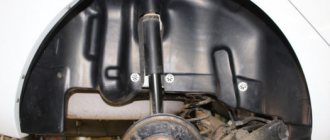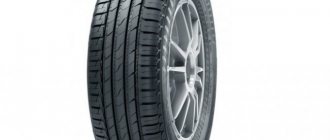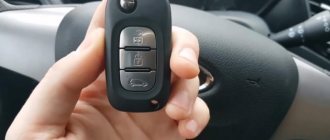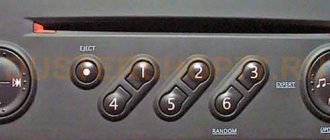The working life of the brake drums on the Lada Vesta depends on the driving style and is approximately 80-120 thousand km. But sometimes parts wear out much faster. When replacing drums, you need to rely on their wear and operation. We advise you to carefully inspect the surfaces of the parts every time you replace the pads - this is enough to replace spare parts on time.
Signs of faulty drums:
- Increased brake pedal travel.
- Slow brake response to pedal pressure.
- Tapping, noise and vibration.
Extraneous sounds and vibrations can also be caused by worn pads. This happens especially often with low mileage.
↑ Features and characteristics of the Lada Vesta brake system
The first glance at the drum brakes of the Lada Vesta causes slight bewilderment: after removing the wheel, the owner will not find any protruding parts or mechanisms. The secret of Vesta is hidden not in nanotechnology, but under the central cap: once you pry it off with a wide flat chisel, the large nut securing the drum will open. It would seem that it is enough to use a 30mm socket, unscrew the fasteners, and that’s it. But that was not the case - you need to perform the following steps:
- Release the parking brake (“handbrake”).
- Using a thin flat tool (screwdriver), rotate the ratchet mechanism to bring the pads together.
- And only after this can you begin to dismantle the drum.
Important. In comparison with other models, the same Granta, the design of the brake system of the rear wheels of the Lada Vesta has undergone significant changes; it will not be possible to apply the previous methods of maintenance and repair to it.
The mechanism has become both simpler and more complex at the same time: in order to “get” onto the ratchet, you will need to insert the slot of a screwdriver into one of 4 holes. But you won’t have to worry about adjusting the parking brake: the adjustment will be done automatically. Experts note that the brake cylinder has become stronger, more solid, and the system itself has become more reliable; a self-regulation function has been added to it.
Correction and assistance system for driving a Lada Vesta car
The Lada Vesta car is equipped with all the most necessary systems that contribute to comfortable driving. All of the systems listed below are present in absolutely all trim levels of the car, which makes it a very attractive figure on the car market. ABS or anti-lock braking system
- in case of emergency, and sometimes regular braking, it prevents the car’s wheels from completely blocking, thanks to this system the braking distance of the car is reduced, and during braking it becomes possible to control the car due to the fact that the wheels are not blocked. When this system operates, you will probably hear a characteristic “crackling” sound and a slight beating of the brake pedal.
EBD or brake force distribution
- correctly distributes the braking forces of the front and rear axles of the car, the system is activated when the ABS is not working correctly, and is indicated on the dashboard as a red indicator - “Brake failure”.
BA or Brake Assist
— this function reads how quickly you pressed the brake pedal; from the data received, the system recognizes whether it was normal braking or emergency braking. In the event of emergency braking, the system will increase the pressure in the brake system drive to a certain level and will maintain it as long as the brake pedal is pressed.
HHC or preventing the car from rolling away when starting off on an incline
- When stopping the vehicle on a slope of four percent or more, the HHC system is activated to help the vehicle continue to move forward, so that the HHC operates correctly, press the brake pedal with sufficient force to ensure that the vehicle remains stationary once the gear is engaged, releasing the brake pedal and pressing the accelerator pedal, the system will hold the car in place until it starts moving, but no more than two seconds. The system automatically turns off if the car is on the parking brake or the driver's door of the car is open.
ESC and TC - or stability control and traction control
— these two functions of the Lada Vesta car work in tandem and are activated automatically when the car engine is turned on. ESC is responsible for the reliable stability of the car on the road, the system reads the rotation speed of all wheels and if one or more of them starts to rotate faster, the system slows down their rotation; in more serious situations, the system resets the engine speed, thanks to which it returns controllability of the car. TC performs the same functions as ESC only when the vehicle is moving off, which reduces excessive wheel slip of the vehicle.
↑ Rear brake design
The principle of operation of the rear wheel braking system of the Lada Vesta has changed little: when you press the brake pedal, the working fluid in the hydraulic line (brake fluid) flows to special cylinders, forcing the piston to move. As a result of this, special pads diverge, pressing against the surface of a disk or drum rotating with the wheel, and the Lada Vesta car stops. As you know, starting with Granta, AvtoVAZ began installing an abs sensor, it remained on later models, only its mounting changed. The brake cylinder body has acquired stiffening ribs, making it stronger and, therefore, more reliable.
Compared to previous generations, the rear brakes on the Lada Vesta lost a tachometer disc, which was often damaged during removal or replacement of pads. It is easy to select the required spare parts, including a brake disc or cylinder, using the Lada Vesta catalog numbers. It should be remembered that not all parts from other models are compatible with West ones.
How does Lada take care of your safety?
Lada Vesta has a special adaptive system in its arsenal, which is designed to ensure maximum convenience of the braking process. The car has built-in electronics that determine how fast and how hard the driver presses the pedal. This allows you to achieve the fastest and most timely stopping of the car in any situation. The computer has an instant response and takes care of the safety of the driver of the Lada Vesta continuously throughout the entire trip.
Lada Vesta is also equipped with a built-in electronic system designed to distribute forces. It turns on at the moment when the load on the disc and drum brakes goes beyond the established norm. This system redistributes the load level, and Lada Vesta continues to move without skidding.
↑ Cost of disc brakes and work to replace them
Despite AvtoVAZ’s agreed decision to install disc brakes on the Lada Vesta at the front and drum brakes at the rear, there are cases when this design is not a priority. These are the following options:
- This refers to the sports modification of the Lada Vesta sedan;
- this is not a production model, but a concept car;
- the standard car was modified to compete in the World Touring Car Championship (WTCC).
In all of these cases, disc brakes will be installed on the Lada Vesta, and this modification will be completely legal.
Important. Replacing standard drum brakes with disc brakes for a regular car, if it is not planned to be used in high-speed races or championships, is unlikely to be a good alternative to the factory equipment. The drum braking system is considered more reliable in urban conditions, since it is almost impervious to weather conditions. Moreover, disk systems are less protected from pebbles, dirt, and slush flying from under the wheels, which adversely affects their performance.
On average, both types of brakes - disc, drum, regardless of their placement, rear or front brakes for the Lada Vesta are equivalent in their effectiveness. Professionals will be able to appreciate the difference, and only at speeds of 120 km/h and above. If you really want to, you can still upgrade, but it will not be cheap, especially since the modernization will have to be legalized.
About the effectiveness of Lada Vesta brakes and reviews about them
Safety on the road largely depends on the braking system of the car, how quickly the car can stop in an emergency.
AvtoVAZ equipped the Vesta with front disc brakes and installed drums at the rear, as on previous Lada models. Let's find out how effective these brakes turned out to be. The Vesta brake system is dual-circuit with a hydraulic drive. One circuit includes the brake mechanisms of the right rear and left front wheels, and the second - the left rear and right front (as on Grant/Kalina/Prior). Thus, if one of the circuits fails, the second circuit, although with less efficiency, will ensure that the car stops.
Vesta is also equipped with an anti-lock brake system (ABS), which prevents wheel locking during sudden braking and braking on slippery surfaces. Let us remind you that AvtoVAZ currently installs ABS on all its models.
The Lada Vesta SW Cross station wagon has disc brakes at the rear, like the Kalina Sport and Grant Sport. It is supplied by TRW. The cylinder diameter is 34mm, the disc is 11mm thick and the brake bolt spacing is 90mm. A similar TRW rear brake is used on Renault cars (models Megan, Clio, Fluence, Scenic and Wind), matches the VAZ caliper in cylinder diameter, but is designed for a disc 8 mm thick and has 82 mm between the mounting bolts.
To test the effectiveness of Vesta's brakes, road tests were carried out, the air temperature was +28 degrees, and the car was equipped with Pirelli Cinturato P1 185/65 R15 summer tires. According to test results, Vesta’s braking distance on dry asphalt and “cold brakes” at a speed of 100 km/h is 32.6 meters. Heated brakes are less effective and during emergency braking they are able to stop the sedan only after 38.4 meters. Video tests:
For comparison, according to Autoreview tests, the braking distance of Vesta’s competitors is:
- Hyundai Solaris - 39.5 meters
- Kia Rio - 40.2 meters.
Brake pad wear on Lada Vesta SW and Lada Vesta SW Cross (determined during life tests):
↑ Signs of brake pad wear
Since the Lada Vesta has become more advanced during the design process, its braking system includes automatic adjustment of the handbrake, which will be effective regardless of the gearbox used - manual or automatic; pronounced signs of pad wear practically do not show themselves. In some cases, the car may experience uneven braking and a slow response to the brake pedal, but this does not necessarily indicate wear on the linings.
More often it is enough to timely replace the brake fluid for the Lada Vesta model and adjust the system. For the Lada, a frequency of 15 thousand kilometers for inspection is established, and it is recommended to change the pads every 60 thousand.
According to information from service specialists, on average, the linings on a Lada car will last 30-45 thousand. Compared to one of the first VAZ 2105s, this is quite a lot.
Discs and drums
Disc brakes, which are installed on the front wheels of the new Lada Vesta sedan, operate on the principle of pads. The discs are manufactured in such a way that they receive good cooling and avoid excessive heating, which can negatively affect their performance and driving safety.
Advantages of disc brakes on Lada Vesta:
- they are better cooled due to constant ventilation and air circulation;
- discs quickly get rid of water and dirt that regularly fall on them;
- The location of the disc brakes on the front wheels gives the car an advantage in braking speed, thanks to which the driver avoids many dangerous situations on the road.
The rear wheels of the Lada Vesta have drum brakes. They, like disk ones, comply with all modern international quality standards and ensure the safety of car owners. The drum system is better suited for driving on bad roads and off-road.
Such brakes work more effectively on unpaved, muddy and dusty roads. They work well even in the most unpleasant weather conditions for the Lada Vesta, but also function well on asphalt.
The combination of drum and disc systems allows the Lada Vesta driver to feel confident on any road, regardless of weather conditions and other external factors. The brakes work with equal efficiency both during fast and quiet driving.
↑ Subtleties of replacing drum brake system pads
Sooner or later, the linings on the rear brake drums of the Lada Vesta will have to be changed. To do this, you will need to find out what type of rear brakes are installed on a particular Lada Vesta sw or sedan. Just as brake pads differ in size from different models, for example, on the Vesta station wagon and Kalina 2, there are no universal solutions for disc and drum systems. It is imperative to determine the catalog number of spare parts for the car, even if a friend with Ford claims that they installed brake pads from Priora at the service center and everything fit perfectly.
In Vesta, the braking system, regardless of the suspension and type of transmission, is clearly divided into front (disc) and rear (drum) drives. To get to the pads, you will first have to remove the wheel by unscrewing 4 nuts. It should be immediately clarified that the Grant brake linings, despite their similarity to the “native” West ones, still will not fit.
In the center of the drum there is a cover under which the fastening nut is hidden. Before dismantling, it is recommended to bring the linings together using a thin screwdriver, rotating the ratchet mechanism, and also release the parking brake. After unscrewing the nut and removing the drum, the rear brake cylinder of the Lada Vesta and, in fact, the system itself will be revealed.
Important. An unconditional reason for replacing brake pads on Largus and any other car is the detection of oiling of the contact surfaces, deep grooves (cracks or chips), and peeling along the body. In this case, the entire set is changed, that is, 4 linings (2 on each wheel), and not individual ones.
What rear pads are on the Lada Vesta
| Catalog article/number | Price in rubles |
| Original | |
| ATE03.0137-0394.2 | From 1600 |
| PILENGABSP8454 | From 1300 |
| Lada Vesta pads article number (analogues) | |
| FORD 1433865 | From 1100 |
| Brembo P68033 | From 100 |
| FENOX BP53013 | From 900 |
| Amiwa CD1841 | From 1100 |
| LYNXauto BS-5717 | From 1350 |
| *prices are as of 04/07/2019. |
Conclusion
Before purchasing, check the catalog article numbers, check the integrity of the product, the presence of packaging, dates and batch numbers.
Try to purchase original products recommended by the manufacturer. Cheap analogues are not famous for their quality and sizing. The service life of the “non-original” part is 25–35% shorter than the factory part.
Which front brake pads are installed by default: depending on the configuration, the model is equipped with pads from Lada or Renault. The exact data is indicated in the car's operating manual.











